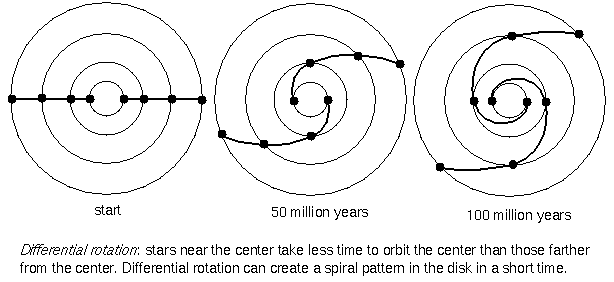

Differential rotation provides an easy way to produce a spiral pattern in the disk. Differential rotation is the difference in the angular speeds of different parts of the galactic disk so stars closer to the center complete a greater fraction of their orbit in a given time. But differential rotation is too efficient in making the spiral arms. After only 500 million years, the arms should be so wound up that the structure disappears. Also, the spiral pattern should occupy only a small part of the disk. The observations of other galaxies contradicts this: the spiral arms in spiral galaxies rarely have more than two turns. Galaxies are billions of years old so the spiral pattern must be a long-lasting feature. What maintains the spiral pattern?
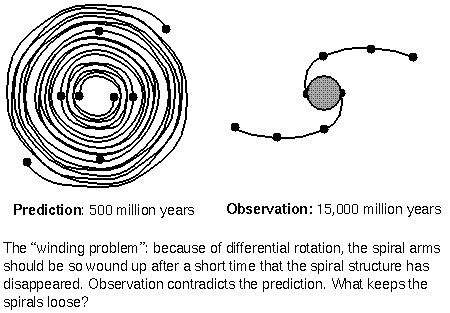
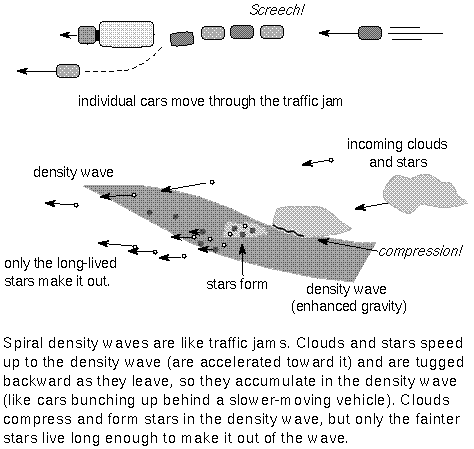
In a galaxy the spiral region of greater gravity concentrates the stars and gas. The spiral regions rotate about as half as fast as the stars move. Stars behind the region of greater gravity are pulled forward into the region and speed up. Stars leaving the region of greater gravity are pulled backward and slow down. Gas entering spiral wave is compressed. On the downstream side of wave, there should be lots of H II regions (star formation regions). This is seen in some galaxies with prominent two-armed spiral patterns. But there are some unanswered questions. What forms the spiral wave in the first place? What maintains the wave?
Computer simulations of galaxy disks with a series of supernova explosions do produce spiral arms but they are ragged and not as symmetrical and full as seen in so-called "grand-design" spirals that have two arms. There are spiral galaxies with numerous, ragged spiral arms in their disks (called "flocculent" spirals), so perhaps the self-propogating star formation mechanism is responsible for the flocculent spirals.
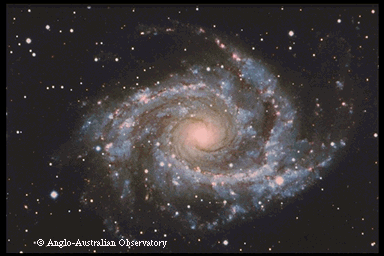 A "grand-design"spiral seen face-on. | 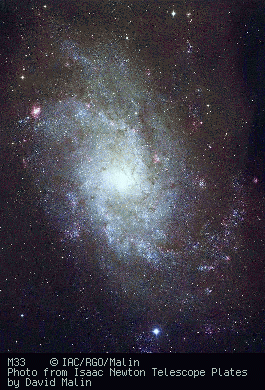 A flocculent spiral with ragged spiral arms. |
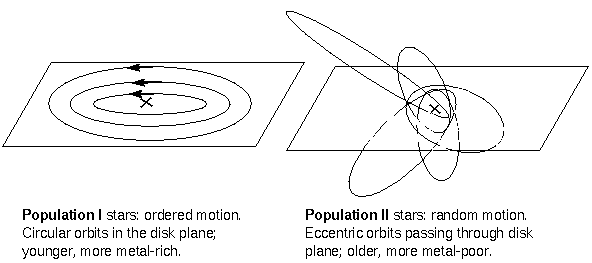
The Population I stars are in the disk component of the Galaxy. They have a wide range of ages, from 0 to 10 billion years old. The youngest ones are in the spiral arms. Population I star orbits are orderly: roughly circular orbits close to the mid-plane of the galactic disk. Young star clusters made of Population I stars are called open clusters because the stars are loosely bound together, in contrast to the old, concentrated globular clusters.
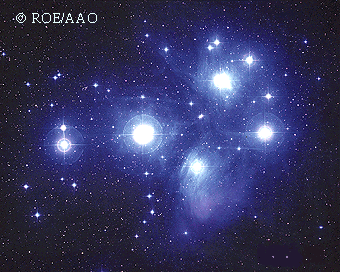
Population I stars have a greater abundance of elements heavier than helium than the Population II stars. Elements heavier than helium are often called metals in astronomy even though many of them are not the shiny conductors called metals in popular usage. The Population I are said to be "metal-rich" in comparison to the Population II stars.
There is a continuum of the metal abundance and orbit shapes. The oldest Population I stars have 0.1 times the metal abundance of the Sun and have slightly elliptical orbits that can take them up to 3000 light years from the disk plane. The middle-aged stars like the Sun have metal abundances of 0.5 to 1 times solar abundance and can be found at heights up to 1100 light years from the disk plane. The young stars have metal abundances of 1 to 2 times the Sun's abundance and stay within 650 light years of the disk plane. Stars less than 100 million years old are found in the spiral arms within 400 light years of the disk plane. They have circular orbits and metal abundances of 1 to 2.5 times solar abundance.
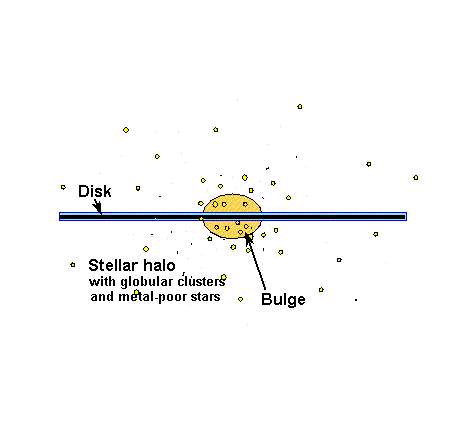
The Population II stars inhabit the spheroidal component (the stellar halo and bulge). They are old: ages range from 10 to 15 billion years old, so they have masses less than or equal to 0.8 solar masses. Their orbits are much more randomly oriented than the Population I orbits and are highly elliptical. The combination of all of the elliptical orbits randomly aligned produces the spherical distribution seen. As a unit the spheroidal component has little overall rotation. Old star clusters called globular clusters are in Population II. Because they swarm around the center like bees around a hive, the globular clusters were used to locate the center of the Galaxy.
The halo stars are metal-poor (0.001 to 0.03 times solar abundance), but the abundance increases inward toward the center. The bulge stars have metal abundances of 1 to 3 times that of the Sun. Early in the history of the Galaxy, there was probably a lot of star formation and death in the bulge component, so the metal content rose quickly. The star formation rate in the disk has been more steady, so it is slowly catching up to the bulge's metal abundance. Star formation now occurs in just the disk. Eventually, the new disk stars will be born with greater metal abundance than the metal-richest bulge stars.
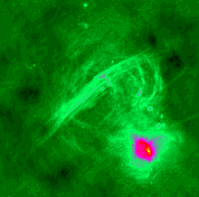
Stellar velocities found from the doppler shifts of the spectral lines in the stars' spectra near the center indicate the presence of a large, compact mass at the center with at least 1 million solar masses. It is probably a massive black hole formed by mergers of stars and stellar remnants. As you look closer to a super-massive black hole, you should see the stars nearer the black hole moving faster than the ones farther out. Stars nearer the super-massive black hole move fast enough to balance the stronger gravity closer to the black hole.
Recent measurements of the tangential motion of the stars close to the center show that the radial velocities measured are for stars moving in circular orbits---that means that the doppler shifts measured are indeed those expected for a super-massive black hole (or compact star cluster) with about 2.5 million solar masses. The compact mass could also be a dense cluster of stars but the mass appears to be concentrated in a region smaller than the size of our solar system. An expanding ring is also seen about 9000 light years from the center. Other galaxy cores have super-massive compact objects (the Andromeda Galaxy, M32, Sombrero Galaxy, M87, and others).
Just because there is a large black hole at the center, does not mean that the stars in the Galaxy are all orbiting around it like the planets orbit the Sun. Even if the super-massive black hole was not there, the stars would still orbit pretty much as they do now because of their mutual gravity. If you compare the enclosed mass inside the Sun's orbit (see the mass figure above) with the 2.5 million solar masses of the black hole, you will see that the central black hole's mass is insignificant compared to the entire Galaxy. A summary of the Milky Way section of this chapter is given next.
What are the "bulge", "stellar halo", "disk", & "dark matter halo" of the Galaxy? Where are old metal-poor stars likely to be found? Where are young metal-rich stars likely to be found? How do you know the dark matter halo exists? Explain how it is known to be there! Using low-power binoculars, how could you determine that you live in a disk galaxy?
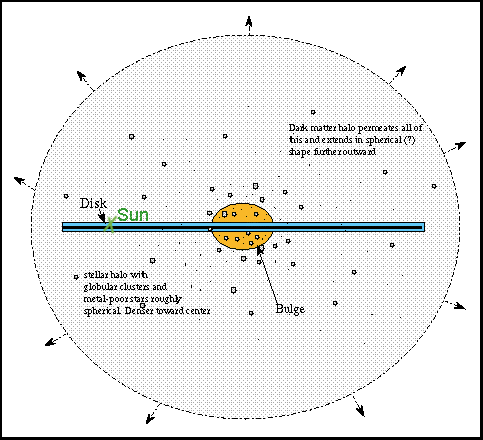
Answer: The components merge smoothly into each other with the stellar halo among the disk and the inner part of dark matter halo and the dark matter halo among the disk, stellar halo, and bulge, etc. The bulge is the elliptical-shaped center part of the Galaxy about 1000 to 2000 parsecs in radius. It had lots of star formation early on, so now it is made of tens of billions of old, metal-rich! stars.
The disk is the thin pancake-shaped part about 400 parsecs thick and 15 to 20 thousand parsecs in radius with the Sun 8000 parsecs from the center. The disk contains over 98% of the dust and gas in the Galaxy and has a few hundred billion stars. Some stars continue to form so the disk has some young metal-rich stars. The gas and dust are found in a layer that is thinner than the star layer (the gas/dust layer is the thin dark line at the midplane of the disk in the picture above and the star layer is the thicker light band).
The stellar halo is a roughly spherical distribution of hundreds of millions of old, metal-poor stars that has increasing concentration of stars toward the center of the galaxy. It is about 20 to 30 thousand parsecs in radius and it may contain small amount of hot gas, but the disk contains the vast majority. Most of the globular clusters are found in the halo and, like the halo stars, the number of them increases toward the galactic center. If the solar system was at the center, you would see approximately the same number of globular clusters in any direction you looked in the sky. Since the globulars are found bunched up in one part of the sky, i.e., they are swarming around some other point in the Galaxy, and we are not at the center. The dark matter halo is denser toward the center. It extends further out than the stellar halo.
The dark matter halo's presence is indicated from the rotation curve---a way to measure the amount of gravity inside a star's orbit, so that the mass inside the star's distance from the galactic center = (orbital speed)2 × (star's distance from the galactic center) / G. The rotation curve is flat even though the light-producing matter's distribution says it should be falling. The dark matter halo may go out as far as 60 to 80 (or more!) thousand parsecs! It is not known what the dark matter is made of (brown dwarfs, black holes, neutrinos with mass?).
Using binoculars you see a narrow band of stars (the "Milky Way") and a large number of gas/dust nebulae that are found only in disk galaxies or irregular galaxies. An irregular galaxy would have a much patchier distribution of material in various parts of the sky and would not produce the narrow band of stars. Only a disk galaxy would make the narrow band with a slight bulging in the direction of the galactic center. (For the Milky Way, the center is in the direction of the constellation Sagittarius.)
![]() Tutorial index page
Tutorial index page
Is this page a copy of Strobel's Astronomy Notes?